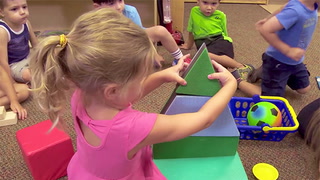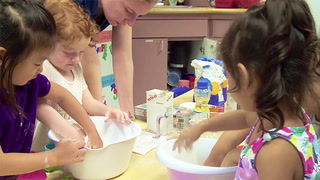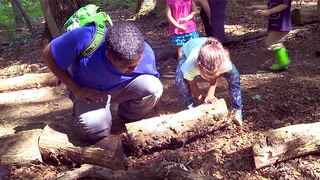Math in Early Learning Transcript
Speaker 1: Children's understanding of math concepts begins to take shape early in life. whether it is sorting the socks as they come out of the dryer, or noticing circular or rectangular shapes throughout the neighborhood. Interesting math opportunities abound and inspire ideas that go deeper than just learning numbers from one to 20.
Children: Five, six.
Speaker 1: Young children can often detect adults math anxiety at a very early age. This can unintentionally shape children's own attitudes and inclinations about math, causing some children to view math as a subject to be avoided or as one they are unable to tackle.
Speaker 2: Stop for one second. Is it balanced?
Children: No.
Speaker 2: No, what do we need to do?
Children: More that way.
Speaker 2: More bears. All right.
Speaker 1: Educators and families can help engage and excite young children in early math learning by finding interesting everyday math experiences that both young children and adults can enjoy.
Speaker 2: You want to stand up and I hand it to you? You got it? All right, here we go. Oh you're going to do it with one hand? Look at her go. Awesome.
Speaker 4: Math is everywhere in early learning. It's not the formal math that many of us think of as adults, but it's everywhere in a child's environment. Young children come in talking about how big they are, how they're bigger than their little brother, how their mommy might be bigger than they are, and so they're automatically comparing sizes. We don't always recognize that as math in the world, but it is everywhere around us.
Speaker 2: My learning goals today were just to introduce the concept of balance, to introduce some vocabulary like center of gravity, weight, light, heavy. Then to have them explore with those things some hands on activity.
All right so the Cat in the Hat by Dr. Seuss. He is the author and the illustrator. Here we go. "The sun did not shine. It was too wet to play. We sat in the house all that cold, cold, wet day." It's the book The Cat in the Hat by Dr. Seuss. As we all know in this story the cat comes in and begins to balance things. The children are worried and express their concern that these things are going to fall over and crash and makes a mess, and the cat continues to balance more and more things.
"Have no fear said the cat. I will not let you fall. I will hold you up high as I stand on a ball with a book in one hand and a cup on my hat, but that's not all I can do said the cat." What is he doing here?
Children: He's getting, he's balancing.
Speaker 2: He's balancing.
Children: I think that he will fall down and trip.
Speaker 2: You think he'll fall down and trip?
Children: He's going to get a lot of stuff.
Speaker 2: Well let's see.
That's a fun inspiration for kids to expand with on their own. In a very simple exercise we can start with inviting children to see if they can stand in a simple position. Can they stand lifting one leg? Can they stand with their arms in a different position? Does that affect their balance?
Now let's watch Harper what she's doing. How is Harper balancing herself? What are you doing Harper to keep your balance?
Children: Arms out.
Speaker 2: Her arms are out. That's right. She's keeping her balance with her arms out.
I think the importance of movement for preschoolers in learning is the ability to engage. It brings a high energy level. They don't want to sit still all the time. They're so inquisitive. They can't wait to get their hands on the materials. When you do something like Cat in the Hat, it allows them the opportunity to build with materials to try to balance. It also allows opportunity for them to work on their fine motor and their gross motor skills as they're getting up and trying to balance themselves. It allows them to work individually and in groups. Bringing literacy in, a story, and then letting them act that out allows them the opportunity to truly grasp the concept of what you're trying to teach to them, whether it be math, science, vocabulary. They truly get involved, and that's what we want. We want them engaging in the materials.
Speaker 4: Give them opportunities to explore that balance in the same way that the cat did in the book so they can begin stacking items to see which items might stack well. In other words, their surfaces match evenly so they're not going to immediately fall over. Can we put flat edges together?
Children: Hey [inaudible 00:04:36]. If you take off a triangle, a big one will stay on.
Speaker 2: If I take off the triangle, the big one will stay on?
Children: Yes.
Speaker 2: All right.
Children: This one.
Speaker 2: That one's heavier? Joe, come over here buddy. Put this one down. Santee says if we take the triangle off and put the big one down it will stay balanced. Will you do that for me? Can you put it there for me and see? Sure, however you want.
Children: Hey, and this will balance.
Speaker 2: Hold on, let him put it down.
Children: Then this will balance.
Speaker 2: It's balanced now. Awesome.
Math is vocabulary of measuring. It's weight. It's balance. It's gross motor skills and fine motor skills growing. When we're talking about balancing our bodies, that's using our gross motor skills. When we're talking about using a scale, that's using your fine motor skills. It's being able to line up on the scale and see is it really balanced. You're teaching children to look at the minute as well as the large.
When you look at the scale, which side, look at the scale, which side is heavier?
Children: This side.
Speaker 2: Why is that one heavier?
Children: Because it has bears.
Speaker 2: Well it has bears in it, but how can you tell using the scale? See here's the fulcrum, the center.
Children: Because it's down.
Speaker 2: Because it's down. It's heavier.
The joy of teaching math in preschool is that you get kids early when they're first learning. If you introduce math concepts to them when they're early and young, they don't have fear of it. You let them explore. You make it hands on. You make it visual, and then what happens. They learn to love math. They're comfortable with math so when they go to kindergarten they go, "No problem, I got it."
Children: Yes it is. It's balanced.
Speaker 2: It's balanced.














8 Comments
Paige Klumpe Sep 25, 2022 2:20pm
She keeps the kids engaged by making the lesson fun and hands-on. Math is something these kids will use their whole lives, and she is teaching them important things in a way that keeps them interested. She also gives them a sense of independence, by giving them time to explore the objects and skills. She is also very encouraging and includes all the children, so none of them feel discouraged.
Nikita Williams Jul 11, 2021 8:49pm
Miss Arnol.d used several hands on and visual models to introduce math into her curriculum
Nikita Williams Jul 2, 2021 10:10pm
Early learners use math to explore their world around them by learning to count their own toys once they learn how to count, by taking something off of the project and seeing that it weighs less Miss Arnold used books and visual examples to teach math, using movement helps kids brain and motor skills engaged.
Diana Tull Jul 7, 2020 10:07am
As a new potential teacher, I am enjoying learning from teachers about ways to introduce Math in Early learning. I like the Cat in the Hat Story by Dr. Seuss which the teacher used because, not only did it allow children to see the power of balance, it also incorporated skills such as listening and language with Math concepts.
Schandrah Conille Feb 22, 2018 6:00pm